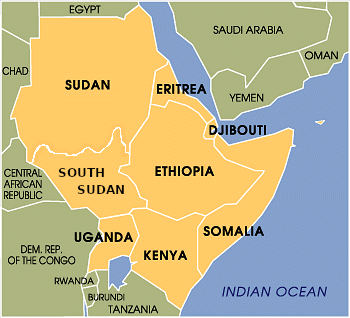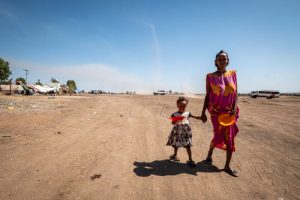ACTION ALERT: Millions at Risk from Evolving Crisis in Northern Ethiopia’s Tigray Region
(UPDATED May 11, 2021)
According to the latest report from the UN Office for the Coordination of Humanitarian Affairs (UNOCHA), at least 4.5 million people in the Tigray region of Ethiopia are in dire need of assistance, with those in rural areas the hardest to reach. Food is scarce and the lack of water, sanitation, and hygiene services has increased the risk of deadly disease outbreaks. What’s more, people in the region have few functional health facilities to turn to.

Map of Horn of Africa. (Copyright: Zeremariam Fre, personal collection. CC BY-SA 4.0)
Beginning in November 2020, thousands of refugees from Ethiopia began streaming across the border into eastern Sudan to escape the fighting between Ethiopian forces and local Tigrayan leaders. As of the latest UN refugee agency report, more than 60,000 Ethiopians from the region are now refugees in Sudan, most residing in camps and settlements. The addition of soldiers from Eritrea into Ethiopia in late November, operating in apparent coordination with the Ethiopian federal troops, added fuel to the fire. Recent evidence of civilian massacres and other atrocities have emerged, and refugees from Eritrea who had been living in Ethiopia, appear to have been a particular target for the Eritrean soldiers.
The fighting couldn’t have broken out at a worse time as people in the region were preparing to harvest their crops, or what was left of them. Farmers throughout East Africa have been struggling against the onslaught of one of the worst locust infestations in decades, driven by heavier rains and milder winters, both exacerbated by climate change.
The following Global Washington members are responding to this evolving crisis. Read about their work below, and if you can, please support their efforts.
- Five Angels: Founder Helen Gebregiorgis is an Ethiopian-American from the Tigray region living in Seattle and member of the Tigray Women’s Association. Because so many have fled to Sudan from the Tigray region, Five Angels has been collecting children’s clothing and over the counter medication to send to Sudan, where over 45,000 Tigrayan refugees have fled. In January 2020, Five Angels Health Clinic was opened in the Tigray region. However, due to the lack of internet and communication, Gebregiorgis is unsure about the state and condition of the building and the staff. Read the full story here.To support these efforts, you can contact Cedric Davis.
- International Rescue Committee (IRC): IRC first began assisting people in Ethiopia in 2000, providing essential aid to over 100,000 refugees from neighboring countries and more than 500,000 Ethiopians affected by previous droughts. Since then, the IRC has expanded to provide a wide range of assistance for refugees living in camps and for vulnerable Ethiopian communities throughout the country. In 2013, the IRC opened the largest water system for any refugee camp in the world. Currently, IRC delivers clean water and sanitation, essential supplies, protection services for women and girls, and other emergency assistance to vulnerable Ethiopians and refugees living in Ethiopia while supporting government-provided health services. Read more about IRC’s work in Ethiopia.
- Medical Teams International: Medical Teams International is working alongside partners to care for displaced Ethiopians in both the Tigray region and Sudan, where many refugees have fled. With your support,Medical Teams International is partnering with World Vision to ship critical medical supplies into Tigray – supplies like syringes, gowns and surgical packs.In Sudan, Medical Teams International will establish a clinic in Um Rakuba refugee camp to provide life-saving care to Ethiopian refugees. Its team will screen for malnutrition and infectious diseases and provide wound care. A team of community health workers will also be trained to share health messages and monitor the health of refugees. To relieve pressure on the local health system, Medical Teams International also will be supporting a hospital near the camp with supplies, equipment and training. This support will be especially important for mothers and children in need of urgent medical care. Read more about Medical Teams International’s work in Ethiopia.
- Mercy Corps: Since 2004, Mercy Corps has been supporting the emergence of a peaceful, prosperous and resilient Ethiopia, inclusive of youth and women. In 2020, its work reached over half a million people across the country. Mercy Corps provides urgent relief to millions of people in Ethiopia, at the same time building longer-term security and stability so that the Ethiopian people can build a stronger future. In response to COVID‑19, Mercy Corps adapted its programs in order to continue reaching communities with lifesaving support. Read more about Mercy Corps work in Ethiopia.
- Oxfam: Since the early 1970s, Oxfam America has been working to address the underlying causes of poverty and marginalization by focusing on developing sustainable livelihoods, providing water and sanitation, agriculture, climate research, gender, and humanitarian issues. Oxfam is currently carrying out programs directly and through partners across eight regions of Ethiopia and one city administration including Amhara, Oromia, Tigray, Somali, Afar, Dire Dawa, Southern Nations, Nationalities, and Peoples Region (SNNPR) and Gambella. Read more about Oxfam’s work in Ethiopia.
- Rotary District 5030: Rotary has a long history of projects in Ethiopia focused on providing safe water and reducing poverty, as well as working independently and with other partners like Splash and World Vision. Rotary has also been a major partner in the efforts to defeat polio, led by Rotarian Ezra Teshome. While these efforts do not directly address the current conflicts, improving the lives of Ethiopians is an important factor in enabling a peaceful living environment. Rotary District 5030 is now supporting its partner Rotary Clubs in Ethiopia, which is taking the lead in defining a series of projects focused on enhancing a culture of peace, dialogue, and conflict prevention and resolution to mitigate the consequences of emerging violence in Ethiopia. Working with the Institute for Economics and Peace (IEP), Rotary District 5030 is supporting training for a network of Peace Ambassadors and economic empowerment to support lasting peace.
- Save the Children: Save the Children was founded to help children suffering in the aftermath of World War I – and remains committed to protecting and providing for children caught up in conflict around the world. In Ethiopia, Save the Children is committed to providing support to children and their families in addressing the immediate and recovery needs of those who have been impacted. Save the Children established a sponsorship program in Tigray in 2001 and has established mobile child-friendly spaces in Sudan to support children in need. Read more about Save the Children’s work in Ethiopia.
- World Vision: World Vision has been among the first agencies to respond with assessments and assistance in a few areas that are safe and accessible and has appealed to donors for $10 million in additional funding as it launched its humanitarian response to the crisis in the conflict-affected Tigray region of Ethiopia. World Vision has mobilized $1.5 million to provide emergency shelter, health, WASH, and protection supplies. World Vision is partnering with Medical Teams International in May 2021 to ship emergency medical equipment to clinics and hospitals in the region.
